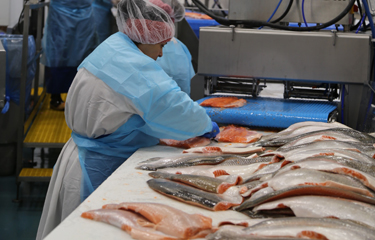U.S. seafood suppliers, processors, and wholesalers are facing a major labor shortage, transportation price hikes, and increased costs of seafood, packaging, and other supplies that are complicating their operations, just as the country looks set to emerge from the yearlong COVID-19 crisis.
National Fisheries Institute President John Connelly said the labor shortage is the latest in a long line of challenges that have beset the industry since the beginning of the COVID-19 pandemic.
“Labor is in tight supply these days and many of our members are feeling the pinch. The entire value chain from catfish farms to tractor trailers are dealing with it, just as they have so many challenges during the pandemic,” Connelly told SeafoodSource.
In some cases, hiring incentives and wage increases are addressing the issue, Connelly said.
“In others, we’ve seen members exploring automation and things like ghost kitchens,” he said. “Unfortunately, there’s no one-size-fits-all fix to safely reopen the country and getting folks back to work.”
Rancho Dominguez, California-based wholesaler, processor, and retailer Santa Monica Seafood can’t find enough workers to fully staff its operations, company president and CEO Roger O’Brien told SeafoodSource. Due to a “significant increase” in its business over the past year – particularly its skin-pack division for retail – the company had 63 open positions at the beginning of May, compared to 22 job openings in early January, according to O’Brien.
“We are having the most difficulty recruiting entry-level packers, cutters, and other manual laborers,” O’Brien said. While Santa Monica Seafood has offered signing bonuses in select cases, he said, “we have remained sensitive to current incumbents who would not receive such signing bonuses.”
“Therefore, we heavily promote job applicants who have been referred to us by current employees. If we hire such applicants, our employee who referred the person receives a generous cash reward,” O’Brien added. The employee referrals typically account for 30 percent of its warehouse and logistic hires.
While the seafood industry has always faced challenges obtaining labor due to the “harsh environment,” Pacific Seafood Vice President of Marketing and Development Bill Hueffner told SeafoodSource, this year has been particularly tough for the processor. In the past, Pacific relied on generational families of fishermen and “that pool is not there like it used to be,” he said.
“Our labor costs are going up, and our ability to find people who are willing to do these jobs is always a challenge because they can work in other environments that aren’t so harsh and make a similar pay,” Hueffner said.
Uniontown, Alabama-based Harvest Select, one of the largest catfish producers in the U.S., is also facing a labor shortage, company president Randy Rhodes told SeafoodSource.
“Normally, I would need more than 350 people, and I am short more than 100 people,” Rhodes said. “Processing is down significantly – more than 20 percent – in the industry and we are all hurting with labor.”
As a result, Harvest Select recently hired a recruiter to talk to individuals in the local community and “teach them what the business is like,” Rhodes said. And Harvest Select has paid above the minimum wage for a few years, but the company has raised its starting wage twice in the past few months to attract new workers.
Rhodes summarized his company’s message to potential employees: “We are a good starting position. Come join us, learn how to be on time and perform the task that is given.”
To alleviate the labor shortage, the seafood industry needs to lobby congressional representatives to urge them to not provide additional unemployment benefits or economic incentives, Rhodes said.
However, the problem doesn’t stop with labor. Freight, fuel, packaging, and operational costs have also risen, Hueffner said, leading to a spike of up to 70 percent in all costs for Pacific over the past year.
“We were having products crated and packaged overseas, but I don’t know if we can continue doing that, because the cost of packaging is so high,” Hueffner said. “Retailers want to go to market with the retail price, but for manufacturers and processors, there is only so much margin left.”
As a result, Pacific has raised its prices over the past year, and “will have to be looking at” additional price increases, Hueffner said.
The aggregate of the squeeze facing the seafood sector is that prices on some species have increased significantly. Among the biggest price-gainers are king crab, snow crab, blue swimming crab, North Atlantic lobster, domestic scallops, Chilean sea bass, and squid, according to O’Brien.
“A majority of these commodity categories experienced 50 percent to 100 percent increases in market value with no promise of price corrections in the near future,” O’Brien said.
At the same time, a number of global farmed fisheries, including Atlantic salmon, remain fairly steady in pricing, according to O”Brien.
“Canada, Scotland, New Zealand, Norway, [and] Australia have all remained relatively flat in year-over-year comparisons,” he said. “A similar picture applies to farmed Asian white shrimp as well as farmed black tiger shrimp.”
While transportation delays have been challenging for Santa Monica Seafood and the industry as a whole, O’Brien said, partnering with select supplier/partners and enabling clear lines of communication “have been critical for our success.”
“Within the majority of our high-volume commodity categories, supplier/partners have greatly assisted SMS with vendor-managed inventories through this pandemic. Having the ability to analyze projections with supplier/partners as they store inventories for SMS in local cold-storage facilities has yielded significant benefits,” O’Brien said.
Photo courtesy of Santa Monica Seafoods







